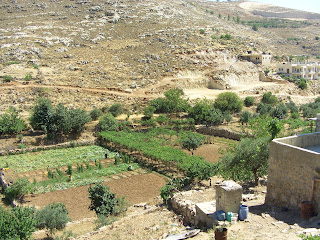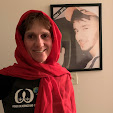




Dear friends and family,
Last week three of us from IWPS made the long journey to the South Hebron hills to participate in two demonstrations. On Friday Internationals and Israelis joined Palestinians in the small village of Wadi Anise for a nonviolent demonstration against the Annexation Wall commemorating the July 9, 2004 International Court of Justice ruling that deemed the wall illegal and instructed Israel to dismantle it. (Obviously that has not happened.) Then on Saturday Internationals and Israelis accepted an invitation from the villagers of Susiya to attend a teach-in and then take a tour of their lands. Since Israeli law forbids them to be on their own land, this was going to be an act of civil disobedience.
To spare you an even longer email than this will already be, I’ll just talk about the event in Susiya.
First some background.
In the 1830s poverty-stricken Palestinian families left their villages in the South Hebron region and purchased land further on the outskirts. The subsequent generations developed a unique culture of living in the spacious caves that dotted the region while sustaining themselves by sheep herding and agriculture. Today many of the villages in the South Hebron hills continue this way of life. One such village was Qawawis. Perhaps some of you remember when I wrote about accompanying the villagers of Qawawis in 2005 who were being severely harassed by settlers. Tragically since then, the settlers have accomplished their objective and the village of Qawawis has been destroyed and the residents evicted. I have no idea where the lovely people with whom I spent three days are now. Probably they are living in poverty-stricken conditions in the near-by villages of Yatta or Carmel.
Susiya is another village in the South Hebron hills that enjoys this cave-dwelling lifestyle. At one point it was situated right next to an archeological site that contains Byzantine, Roman and Hellenistic ruins and the ruins of an ancient Jewish synagogue. In 1983 Jewish settlers established a settlement 2 km from this site and they named themselves Susya. (Did they choose the name to obfuscate the reality of the pre-existing Arab village of Susiya?) In 1985 the military took control of the site and in 1986 evicted the families of Susiya from their homes. The families relocated 500 meters from the Jewish settlement. This was way to close for the comfort of the settlers and so the army evicted the villagers a second time, herding them into trucks and dumping them 15 km to the north. While some families gave up and went to live in Yatta, other families returned to their land, this time a little further from the settlement.
In the next few years the area saw the spread of settlement outposts, illegal even by Israeli law. (By international law, all settlements are illegal.) Nonetheless, under the protection of the Israeli army the settlers were able to grab more and more land belonging to the remaining families of Susiya. Increasingly violent in their actions, (three Susiya residents were murdered by settlers in 1991) settlers stopped Palestinian farmers from cultivating their lands. Once land lays fallow, the state can “legally” claim it. Half of the families have lost half of their lands and the remaining half have lost all of their lands. (See Peace Now report “Breaking the Law in the West Bank – The Private Land Report”, November 2006
http://www.peacenow.org.il/site/en/peace.asp?pi=61&fld=495&docid=2024&pos=3)
In July 2001 a settler was murdered outside the fence of the Susya settlement. Although no one from the village was implicated, the Israeli army carried out a third eviction, much more brutally than the previous ones. Villagers were beaten and/or arrested, caves were demolished, wells blocked with sand and rocks, fields destroyed, 1000 olive trees uprooted, livestock buried alive. Despite this treatment and the insistence of the army that they leave, many of the families of Susiya stayed on their land. The Red Cross brought emergency relief supplies and one week later the army returned to bulldoze the Red Cross tents. (See B’Tselem report “Means of Expulsion: Violence, harassment and Lawlessness against Palestinians in te Southern Hebron Hills”, July 2005
http://www.btselem.org/english/Publications/Summaries/200507_South_Hebron.asp)
In September 2001 the villagers submitted a petition to the Israeli High Court of Justice (HCJ) requesting a permit to return to their land. The HCJ pronounced the repeated expulsions illegal and presented an interim injunction instructing the army to allow the inhabitants to return to their land, albeit with the restriction that they could not rebuild anything. Hence, since this time, the families of Susiya have been living on their land in tents and shacks.
In September 2004 the HCJ left intact the injunction from 2001 barring the Israeli military from demolishing and evacuating the village of Susiya. The judges even went so far as to reprimand the state, saying, “...the state ...is creating a situation under which a human’s basic existence becomes impossible.” The HCJ gave the villagers until July 2007 to submit a required building plan which a requirement for obtaining legal building permits. While this sounds quite reasonable, it is important to realize that the villagers have been denied permission for surveyors to go on the land to obtain the measurements needed for a viable building plan. Furthermore, the body that issues permits is primarily made up of settlers and virtually never approves building permits for Palestinians. Such is the Catch-22 circumstances of life in Palestine.
The teach-in and tour that we attended with about 50 other Internationals and maybe 150 Israelis marked the deadline for submitting the building plan. Without it they cannot possibly hope to obtain the building permits. In one month the deadline for obtaining the building permit will pass. After that the villagers can expect the army to come and evict them for a fifth time.
At the beginning of the teach-in some Israeli border police showed up and I feared they would prevent the event from proceeding. Fortunately, they left after talking to some of the villagers and the teach-in continued. When the teach-in ended, we were served a simple lunch of delicious homemade bread, cucumbers, tomatoes and several rounds of tea. Then the tour began. We were shown the remains of their destroyed houses that they have been forbidden to rebuild. We were shown their current dwellings that are merely tents. We were shown the settlement outposts on top of the hills overlooking their land. The archeological site was pointed out to us as well. And finally we walked on the villagers’ land that is now claimed by the settlers. Waiting for us were about 18 soldiers and 12 border police. Without the presence of so many Internationals, Israelis and press it would have been very dangerous for the villagers to be there. After some chanting and bannering, we all left and went back to the land that at least for now the villagers arestill allowed to occupy.
Of course by the end of the day we were all without words. What can you say to people who are facing such circumstances? We thanked them for their hospitality and left.
Love,Wendy






















































